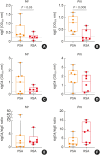Defining Biomarkers to Predict Natural Resolution in Shrimp Allergy
- PMID: 35255538
- PMCID: PMC8914604
- DOI: 10.4168/aair.2022.14.2.210
Defining Biomarkers to Predict Natural Resolution in Shrimp Allergy
Abstract
Purpose: Tolerance to shrimp has been reported in some patients with a history of shrimp allergy. The predictors of the natural resolution of shrimp allergy have not been widely explored. This study aimed to investigate the role of specific IgE (sIgE) and specific IgG4 (sIgG4) to shrimp extracts and the cross-reactive shrimp allergens tropomyosin (TM), arginine kinase (AK) and myosin light-chain (MLC), as markers of persistent or resolved shrimp allergy (PSA or RSA).
Methods: Seventeen patients with a 10-year history of allergy to Penaeus monodon (Pm) and/or Macrobachium rosenbergii (Mr) were recruited. Oral shrimp challenges identified 10 patients with PSA and 7 patients with RSA. Sera from these patients were evaluated for sIgE and sIgG4 to Mr and Pm extracts as well as to TM, AK and MLC.
Results: The levels of sIgE to Mr and Pm extracts were lower in the RSA than in the PSA groups (P = 0.05 and P = 0.008, respectively), but sIgG4 or sIgG4:sIgE ratio did not show statistical significance. The sIgE to AK and MLC, but not TM, were lower in the RSA group than in the PSA group (P = 0.009 and P = 0.0008, respectively). There was no difference in sIgG4 to TM, AK and MLC between both groups. The ratio of sIgG4:sIgE to MLC, but not TM or AK, was higher in the RSA than in the PSA group (P = 0.02). A higher diversity of sIgE to shrimp components was found in the PSA group than in the RSA group (P = 0.006).
Conclusions: Specific bioassays can be used to identify patients with RSA. Oral shrimp challenges in these patients may provide a higher rate of passing the challenges and finally reintroducing shrimp in their diet.
Keywords: Food hypersensitivity; arginine kinase; biomarkers; crustacea; immune tolerance; immunoglobulin E; myosin light-chains; shrimp; tropomyosin.
Copyright © 2022 The Korean Academy of Asthma, Allergy and Clinical Immunology • The Korean Academy of Pediatric Allergy and Respiratory Disease.
Conflict of interest statement
There are no financial or other issues that might lead to conflicts of interest.
Figures



References
-
- Santadusit S, Atthapaisalsarudee S, Vichyanond P. Prevalence of adverse food reactions and food allergy among Thai children. J Med Assoc Thai. 2005;88(Suppl 8):S27–S32. - PubMed
-
- Jirapongsananuruk O, Bunsawansong W, Piyaphanee N, Visitsunthorn N, Thongngarm T, Vichyanond P. Features of patients with anaphylaxis admitted to a university hospital. Ann Allergy Asthma Immunol. 2007;98:157–162. - PubMed
-
- Ganapathy S, Lwin Z, Ting DH, Goh LS, Chong SL. Anaphylaxis in children: experience of 485 episodes in 1,272,482 patient attendances at a tertiary paediatric emergency department from 2007 to 2014. Ann Acad Med Singapore. 2016;45:542–548. - PubMed

